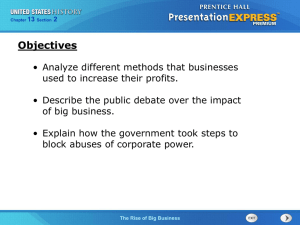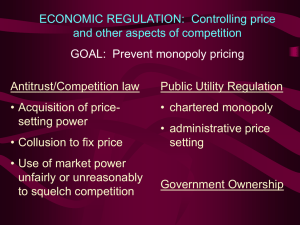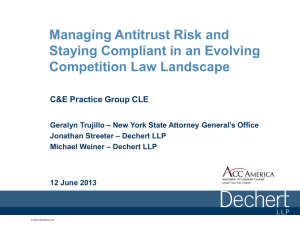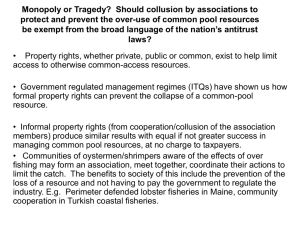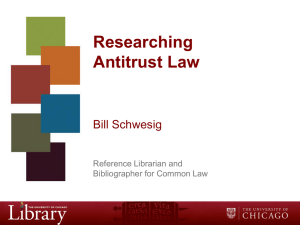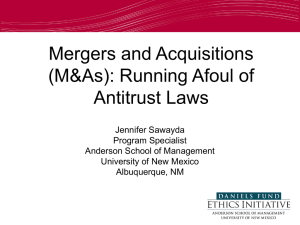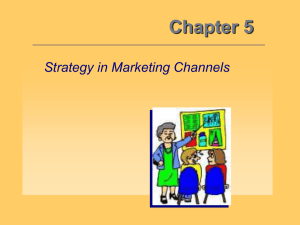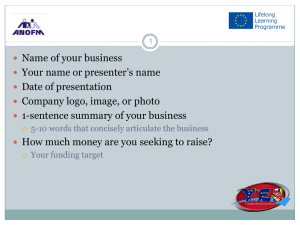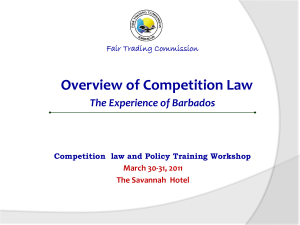CLE webinar - Bona Law PC
advertisement
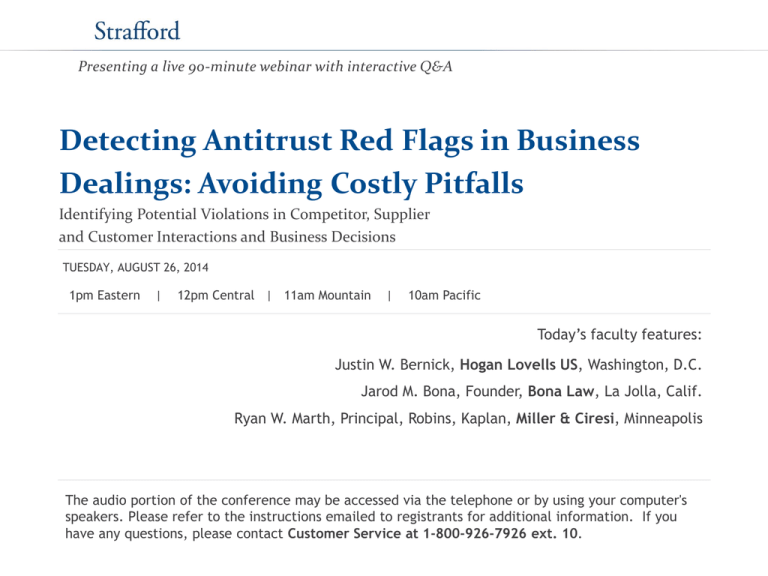
Presenting a live 90-minute webinar with interactive Q&A Detecting Antitrust Red Flags in Business Dealings: Avoiding Costly Pitfalls Identifying Potential Violations in Competitor, Supplier and Customer Interactions and Business Decisions TUESDAY, AUGUST 26, 2014 1pm Eastern | 12pm Central | 11am Mountain | 10am Pacific Today’s faculty features: Justin W. Bernick, Hogan Lovells US, Washington, D.C. Jarod M. Bona, Founder, Bona Law, La Jolla, Calif. Ryan W. Marth, Principal, Robins, Kaplan, Miller & Ciresi, Minneapolis The audio portion of the conference may be accessed via the telephone or by using your computer's speakers. Please refer to the instructions emailed to registrants for additional information. If you have any questions, please contact Customer Service at 1-800-926-7926 ext. 10. Tips for Optimal Quality FOR LIVE EVENT ONLY Sound Quality If you are listening via your computer speakers, please note that the quality of your sound will vary depending on the speed and quality of your internet connection. If the sound quality is not satisfactory, you may listen via the phone: dial 1-866-961-8499 and enter your PIN when prompted. Otherwise, please send us a chat or e-mail sound@straffordpub.com immediately so we can address the problem. If you dialed in and have any difficulties during the call, press *0 for assistance. Viewing Quality To maximize your screen, press the F11 key on your keyboard. To exit full screen, press the F11 key again. Continuing Education Credits FOR LIVE EVENT ONLY For CLE purposes, please let us know how many people are listening at your location by completing each of the following steps: • In the chat box, type (1) your company name and (2) the number of attendees at your location • Click the SEND button beside the box If you have purchased Strafford CLE processing services, you must confirm your participation by completing and submitting an Official Record of Attendance (CLE Form). You may obtain your CLE form by going to the program page and selecting the appropriate form in the PROGRAM MATERIALS box at the top right corner. If you'd like to purchase CLE credit processing, it is available for a fee. For additional information about CLE credit processing, go to our website or call us at 1-800-926-7926 ext. 35. Program Materials FOR LIVE EVENT ONLY If you have not printed the conference materials for this program, please complete the following steps: • Click on the ^ symbol next to “Conference Materials” in the middle of the lefthand column on your screen. • Click on the tab labeled “Handouts” that appears, and there you will see a PDF of the slides for today's program. • Double click on the PDF and a separate page will open. • Print the slides by clicking on the printer icon. Detecting Antitrust Red Flags in Business Dealings: Avoiding Costly Pitfalls Justin W. Bernick Hogan Lovells US justin.bernick@hoganlovells.com Jarod M. Bona Bona Law jarod.bona@bonalawpc.com Ryan W. Marth Robins, Kaplan, Miller & Ciresi rwmarth@rkmc.com Overview 6 • This is a simplified bullet-point presentation that is not intended to make you an expert. • When in doubt, consult the legal department or qualified outside counsel. US Antitrust Basics 7 • Sherman Act, Section 1: Prohibits certain agreements and understandings between competitors, customers and suppliers, or other firms with business relationships • Sherman Act, Section 2: Prohibits certain conduct by a monopolist or by someone attempting to become a monopolist and certain other forms of unilateral conduct • Clayton Act: ‒ Section 3: Prohibits anticompetitive conditions on the sale of goods, including “tying” and some exclusive dealing. ‒ Section 7: Governs mergers and acquisitions. • FTC Act: Prohibits unfair methods of competition and unfair acts and practices. • State Antitrust Acts: Often follows federal antitrust laws, but there can be some variation. Section 1 Flowchart Agreement? 8 Yes No Sherman Act 1 Horizontal Vertical Per Se (pricefixing, market allocation, etc.) Rule to Reason Naked Cartel? Criminal Penalties No Civil Liability (Treble Damages) Sherman Act 2 Market Power / Harm to Competition Restraint Necessary for Procompetitive Benefit? No Market Power / No Harm to Competition Yes No Liability Evidence of a “Conspiracy” Under Section 1 9 • Contract • Direct Evidence • Circumstantial Evidence ‒ Circumstances must reveal “a unity of purpose or a common design and understanding, or a meeting of minds in an unlawful arrangement” 328 U.S. 781, 810 (1946) ‒ When circumstantial evidence is used, there must be some evidence that "tends to exclude the possibility" that the alleged conspirators acted independently. Monsanto Co. v. Spray-Rite Service Corp., 465 U.S. 752, 764 (1984) • Parallel pricing plus “plus factors” • Price signaling / information exchanges • Joint Ventures – Do participants deprive the marketplace of independent decisionmaking? Distinguishing horizontal from vertical agreements 10 • Horizontal agreement – agreement among firms at the same level of production (competitors or potential competitors) • Vertical agreement – agreement among firms at different levels of production (manufacturer and wholesaler / wholesaler and retailer) Distinguishing Horizontal from Vertical Agreements: Hybrid Agreements 11 • “Hub and Spoke” agreement has elements of both horizontal and vertical agreements. ‒ “Ringleader” is the dominant purchaser or supplier who enters into a series of agreements with the distributors or “spokes” ‒ In order to prove a hub-and-spoke conspiracy, one must establish evidence of the “rim,” i.e., horizontal agreements among the spokes. Distinguishing Horizontal from Vertical Agreements 12 Toys R Us v. FTC, 221 F.3d 928 (7th Cir. 2000) • Toys ''R'' Us had used its dominant position as toy distributor to extract agreements from and among toy manufacturers to stop selling to warehouse clubs the same toys that they had sold to other toy distributors. • Toys ''R'' Us denied there was sufficient evidence to prove a horizontal conspiracy among the toy manufacturers, with itself as the ringmaster. It was possible that each manufacturer had an independent motive to stop selling the warehouse clubs and this possibility had not been disproven. The court disagreed, citing testimony from toy company executives and Toys ''R'' Us that each toy manufacturer would agree to Toys ''R'' Us's demands only if its competitors were doing the same. Thus, there was sufficient circumstantial evidence that excluded the possibility that the conspirators acted independently. Distinguishing Horizontal from Vertical Agreements 13 United States v. Apple (e-books), No. 12 Civ. 2826 (Jul. 10, 2013) • Amazon launches successful e-book platform, driving down publishers’ royalties. • When launching iPad, Apple persuades publishers to adopt “agency” model, preserving their profits. • Apple insists on MFN with respect to competitors, restricting Amazon’s ability to offer lower-priced product • Emails/Communications from Apple assuring publishers that others were on board. • Court found after trial that Apple facilitated a per se illegal agreement. Per Se Violation or Rule of Reason? 14 • Liability for “per se” violations is established upon proof of the agreement. ‒ Generally reserved for conduct that courts have significant experience with. ‒ Types of “per se” illegal conduct include price fixing, bid rigging, and market allocation. ‒ Herein lie the “landmines” for counselors. • Rule of Reason applies to vast majority of cases: “where the economic impact of certain practices is not immediately obvious.” ‒ Rule of reason requires proof of harm to competition in a relevant market. ‒ But rule of reason “does not open the field of antitrust inquiry to any argument in favor of a challenged restraint that may fall within the realm of reason.” Most Common Per Se Violations 15 • Price and volume agreements: Includes price or any price components, including discounts, promotions, credit or other terms, allowances, advances, mark-ups, costs, margins, or price ranges. • Market Allocation. Agreements among competitors about where to sell, what products to sell, and whom to sell to. • Group Boycott. Agreements to not deal with potential customers, or to jointly insist upon certain terms • Bid Rigging. Collusive bidding practices. Rule of Reason 16 • Most conduct falls into this category. • Virtually all vertical conduct is judged under the rule of reason. • Courts will balance the pro-competitive benefits against any anticompetitive harm. • Quick Look review: Between rule of reason and per se review. Courts are increasingly applying standards that are neither pure per se or pure rule of reason. The “Special Situation” of Joint Ventures 17 • Per Se illegal if restriction is naked ‒ E.g., Countywide MLS includes fixed support fees for members. Freeman v. San Diego Ass’n of Realtors, 322 F.3d 1133 (9th Cir. 2003). • Rule of Reason applies if restriction is reasonably related to the purpose of the joint venture. ‒ E.g., Visa/MasterCard restrictions on banks issuing Discover/AmEx cards. United States v. Visa, 344 F.3d 229 (2d Cir. 2003). • “Quick look” rule of reason applies to agreements that can be condemned by an observer with a rudimentary understanding of economics. ‒ E.g., association of dentists agrees not to provide X-rays to insurers. FTC v. Ind. Fed’n of Dentists, 476 U.S. 447 (1986). Information Exchanges: Risks 18 • Any information sharing among competitors can create the possibility of an antitrust violation. • Information-sharing may facilitate a per se antitrust violation. • Directly sharing any of the following types of information with competitors heightens antitrust risk: ‒ Pricing, promotions, costs, market shares; ‒ Past, current, or future marketing, pricing, plans, etc.; or ‒ New product developments that are not yet public Information Exchanges: Safe Harbor 19 The FTC and DOJ’s Statements of Antitrust Enforcement Policy in Health Care define safety zones for information exchanges among competitors (in all industries): • Past and current price information may be shared if 3 conditions are met: 1. 2. 3. Data collection managed by third party. Data shared with competitors > 3 months old. Data aggregated among 5 or more competitors, none of whom have 25% or greater market share. • Information sharing outside of safety zone judged on caseby-case basis considering nature of information, extent of communication among competitors, rationale for sharing information and whether information is shared with customers. • Sharing of non-price information is generally treated more leniently. Trade Associations 20 • Counsel should be present at all meetings. • Written agenda should be prepared, approved in advance, and followed. • No agreement (express or implied) that limits each member’s right to make independent decisions. • If there is any inappropriate discussion, announce you are leaving and walk out. • Be careful what you say at social gatherings. Vertical Agreements 21 • Announcing a policy and adhering to it does not constitute an agreement. ‒ So a manufacturer terminating a retailer for not abiding by a suggested minimum price/min. advertised price is not an agreement. ‒ But offering incentives to abide by minimum prices can be an agreement. ‒ And lax enforcement, inconsistent enforcement, or “negotiations” with noncompliant parties can support inference of agreement. • Adopting a policy at the behest of competing retailers/distributors/manufacturers may raise inference of agreement (possibly a horizontal one). Vertical Price Agreements 22 Factors that raise the inference of an anticompetitive vertical agreement: • Minimum prices adopted at the behest of retailers • A dominant retailer insists on RPM to forestall retail innovation • Retail price maintenance helps manufacturers monitor each others’ prices • Manufacturer with market power uses RPM to discourage retailers from selling others’ products Leegin Creative Leather Prods. v. PSKS, Inc., 551 U.S. 877 (2007). Rule of Reason – Market Definition and Market Power 23 • Market Power – ability to raise prices, decrease output, or exclude competition ‒ Direct Proof of Market Power • Actual evidence of an ability profitably to raise price or exclude competitors ‒ Indirect Proof of Market Power • Define Market • Market shares (generally over 50% / not lower than 25%) suggest market power. • Barriers to entry suggest market power Rule of Reason – Proof of Harm to Competition 24 • Plaintiff has burden to show harm to competition ‒ Increase in prices (e.g., architects’ ban on price bidding raises prices). Nat’l Soc. Of Prof. Engineers v. US, 435 U.S. 679 (1978). ‒ Decrease in output (e.g., NCAA limits member schools to 2 TV football games per year). NCAA v. Bd. of Regents of Univ. of Okla., 469 U.S. 85 (1984). ‒ Exclusion of competition (e.g. Visa/MasterCard bans on issuing AmEx/Discover limits rivals’ ability to compete). US v. Visa, 344 F.3d 229 (2d Cir. 2003). • Harm to competitors does is not sufficient standing alone to meet plaintiff’s burden. Rule of Reason – Procompetitive Justification 25 • Competitive Justification ‒ Must be efficiency enhancing • Increase Output (joint marketing agreement allows companies to enter new market). • Create a New Product (musicians’ “blanket license” sold to TV/radio stations). Broadcast Music Inc. v. CBS, Inc., 441 U.S. 1 (1979). • Decrease Prices (Joint buying group gives members lower input prices). N.W. Wholesale Stationers v. Pacific Stationary & Printing Co., 472 U.S. 284 (1985). • Prevent free-riding (National moving company prevents members from competing against national company on long-haul business). Rothery Storage Van Co. v. Atlas Van Lines Inc., 792 F.2d 210 (D.C. Cir. 1986). ‒ Justifications that themselves harm competition are not cognizable • Enhance competitors’ profits • Protect competitors from competition Sherman Act Section 2 26 • Monopolization, Attempted Monopolization, and Conspiracy to Monopolize • Monopolization: • Monopoly Power: The ability to set prices, control output, or exclude competitors in a given market. • Exclusionary Conduct to acquire, maintain or enhance that power. • It is not illegal to acquire or maintain monopoly power as a result of superior product or business acumen. • Attempted Monopolization: A company that (1) engaged in exclusionary conduct with an (2) intent to gain monopoly power and (3) has a “dangerous probability” of gaining monopoly power. Sherman Act Section 2 27 • Attempted Monopolization requires that the company has ‒ Engaged in exclusionary conduct with an ‒ Intent to gain monopoly power and has ‒ A “dangerous probability” of gaining monopoly power • Conspiracy to Monopolize generally occurs where firms that together possess monopoly power combine to further enhance or maintain their power through competitively unreasonable means. Sherman Act Section 2 28 Monopoly Power • Market share is typically used a proxy for measuring market power. • Typically, at least 70% of a properly defined market is necessary for market power. • Even with high market shares, an entity may lack market power if there are low barriers to entry or competitors may quickly expand production. Sherman Act Section 2 29 Exclusionary Conduct • The standard is in flux and courts do not always agree. • There must be a reduction in overall competition in the market or harm to consumers (higher prices, reduced quality, etc.) • The form is only limited by the imagination of the offending companies and the plaintiffs and prosecutors. • Examples: Refusals to deal, exclusive dealing, marketshare discounts, tying, bundling • Does it include an “agreement”? If so, it can also be challenged under Section 1. Mergers & Acquisitions 30 • Section 7 of the Clayton Act restricts “acquisitions” where the effect “may be to substantially lessen competition.” • Acquisition interpreted broadly to mean “anything of value.” • Certain transactions require the filing of Hart-ScottRodino Act (HSR) forms with the antitrust agencies. • FTC levies significant fines for failure to file reportable transactions, regardless of effect on competition. When in doubt, file! Mergers & Acquisitions 31 Avoid “gun jumping” (coordinating with merger partner before approval) Questions to ask when assessing pre-merger coordination and information exchange: • Is the exchange necessary to due diligence process? • Is information generalized/aggregated to remove details about specific customers? • When in the merger process is the information exchanged (the earlier the exchange the greater the risk)? • What safeguards are employed to restrict access to sensitive information (third parties, Chinese walls, etc…)? Robinson-Patman Act 32 • Prohibits sale of products (not services) of like grade and quality to different buyers at different prices if harm to competition • Various defenses apply: ‒ ‒ ‒ ‒ Discount justified by different costs Discount justified by meeting competition Sales not comparable because of changing conditions Discount practically available to other purchasers • Rarely enforced by agencies, but private lawsuits possible Antitrust compliance 33 Why Have an Antitrust Compliance Program? • Prevent hard core cartel activity that can lead to criminal charges • Educate employees about basic antitrust principles and types of conduct that raise more subtle antitrust concerns • Detect prohibited activity and permit prompt remedial action ‒ Including, if necessary, participation in applicable leniency programs Antitrust compliance 34 …and why not? “A corporate compliance program generally will not protect a company from prosecution and certainly will not protect it from potentially devastating treble damage liability. Therefore, every company’s first objective in its compliance program should be to prevent wrongdoing.” William J. Kolasky Former Deputy Assistant Attorney General DOJ Antitrust Division Critical initial steps 35 1. Secure management buy-in and support ‒ Message that company abides by the antitrust laws must come from the top ‒ Critical to secure necessary resources 2. Assess risk 3. Consider guidance from enforcers 4. Think globally ‒ Some jurisdictions interpret antitrust laws to reach conduct occurring anywhere in the world ‒ Most laws based on same principles but important differences in specific prohibitions and enforcement tools and priorities ‒ Trend toward issuing single policy, potentially with separate guidelines for different jurisdictions Implementing the program 36 Principal Elements: • Policy and guidelines/manual • Mechanisms for monitoring, enforcing, reporting • Audits • Training Policy and guidelines/manual 37 • Communicates the organization’s standards and procedures • Can be simple statement by head of company stating the company’s commitment to adhere to the antitrust laws • Best to include practical guidance for employees on topics of relevance to the organization ‒ Can be in the form of “dos and don’ts” or more detailed ‒ Should cover core prohibited conduct (e.g., price fixing) and areas where employees should engage counsel for further review Mechanisms for monitoring, enforcing, reporting 38 A compliance program without robust monitoring, enforcement, and reporting mechanisms is “merely a ‘paper program,’ ” not one that is adequate to “detect the particular types of misconduct most likely to occur in a particular corporation’s line of business.” Memorandum from Larry D. Thompson Deputy Attorney General Jan. 20, 2003 Effective monitoring 39 • Designated employee responsible for antitrust compliance who reports to the board ‒ Familiarity with industry in which company operates ‒ Regular engagement with business leaders and senior management • Specific guidelines on what should be reported • Reporting procedures ‒ In-person and confidential form/hotline ‒ Prompt and thorough follow up is critical ‒ Consider in-house leniency system? Audits 40 • Most common tools: ‒ on-site visit ‒ interviews of selected employees ‒ document/e-mail reviews • Generally performed by outside counsel • Critical aspect of compliance program per U.S. Sentencing Guidelines, but on practical level, may be excessive for low-risk companies Training 41 • Training content and delivery should be tailored to organizational culture and individual roles • Efforts should be targeted toward executives and higher risk employees ‒ Examples: sales, marketing/pricing, trade association participants, dealings with suppliers/customers ‒ Consider non-obvious groups (e.g., human resources, employees in charge of external social media) ‒ Training audience should be reviewed regularly to account for changes in the organization Training 42 Effective antitrust training combines: • Understanding of company’s objectives, preferences and style − Relevant issues − Strategy − Risk profile • Understanding of the audience (executives vs. day-to-day sales) • Knowledge of the relevant industry − Certain laws apply to certain industries but not others • Knowledge of antitrust regulators’ trends • Practical pointers and examples • Follow-up − Where does a business person address questions? − Where should compliance concerns be conveyed? − Potential test or refresher trainings? Claims Against Cartels 43 Identifying when you have been a victim of cartel activity: • Sudden, industry-wide increases in price. • Common explanation for increases. • The increased price is for a commodity. • The sellers are “repeat offenders” (electronics, agriculture, chemical sectors). • Excess capacity for product in question. • Competitors have list prices that are easily monitored. Claims Against Cartels 44 Potential remedies for cartel conduct: • Private treble damages available in U.S. ‒ Depending on the circumstances, it may make sense to act as a class representative, individual (opt-out) plaintiff, or absent class member. • Private damages actions are also growing in Canada, the U.K., and European Union. • Antitrust counsel can help sort through the multiple (and often overlapping) layers of enforcement to help businesses execute successful global recovery strategies. Q&A To ask a question from your touchtone phone, press *1. To exit the queue, press *1 again. You may also use the Chat function to ask questions, or email questions to antitrustlaw@straffordpub.com CLE CODE: TLAAAI After you complete a brief survey of this program, we'll send you a free $5 Starbucks Gift Card. Tell us how we did! Look for our 'Thank You' email (which you should receive shortly) for details and the survey link! Thanks. Please join us for our next conference, “????????,” scheduled on Tuesday, September 16, 2014 starting at 1pm EDT. Strafford Publications, Inc. 1-800-926-7926 www.straffordpub.com
